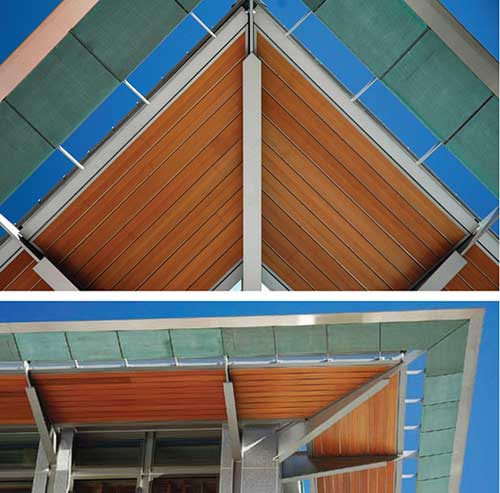Real Wood Veneer: The Sustainable, High-quality Product Choice
Installation Considerations.Advanced finger jointing technology with grain-matching veneer has enabled manufacturers to provide profile wrapped products in 14-foot, 16-foot and, now, 18-foot lengths - all difficult to achieve in both quantity and quality when using solid hardwood lumber. With these lengths, most surfaces will require no end joints, resulting in a clear, defect-free board stretching the full length of the walls and ceilings in most houses or office buildings. Ceiling applications, in particular, are much simpler to handle, and easier to install, when they are long enough to span the entire room.
Long-length products can be installed in one piece, so installation is faster and less costly than random length solid mouldings because there are fewer joints to scarf and nail. In addition, wrapped products require minimal preparation, result in fewer seams, and do not require pre-drilling. And because they can be produced to specified lengths, job site waste is significantly reduced, as is the impact on the environment and the wood fiber resource.
Reductions in installed cost of wrapped products versus solid wood equivalents can be dramatic. The Hills of Troy, a master planned community located near the Twin Cities in Wisconsin, is a 270-acre development with more than 70 acres devoted to conservation and crisscrossed by scenic nature trails and recreation areas. Builders of the homes sought to complement the natural exterior environment, and specified hardwood veneered mouldings using a finger-jointed pine substrate. Some 5,000 lineal feet of cherry veneer-wrapped mouldings including crown, base, window and door trim, cove ceiling and stair parts throughout each house were used. The savings on the installed cost of the wrapped products compared to solid cherry hardwoods: 30 percent. Â
Performance. While production of standard wrapped components predominates in the industry, increasingly, profile veneer wrapping comes as a solution to an architect's or other end user's request, with some manufacturers maintaining that a large part of their annual output represents one-of-a-kind solutions to unique situations which may never be used again.Â
With today's sophisticated no added formaldehyde (NAUF) polyurethane moisture curing adhesive technology, veneer-wrapped products have eliminated de-lamination concerns, enabling them to be more dimensionally stable than solid wood, with less warping and cracking. And wrapped products can sometimes perform where a solid wood component cannot - because solid wood is too heavy, unwieldy, difficult to produce, does not meet performance expectations or otherwise just won't do.
Case in point: the veneer wrapped solution specified by Zimmer Gunsul Frasca Partnership as architects for UC Berkeley's new Stanley Hall. The Portland, Oregon-based architectural group was unable to use cedar wood soffits as the International Building Code does not allow solid wood for this application. Design integrity was maintained and the fire rating dilemma was overcome by profile-wrapping a western red cedar veneer over custom-formed aluminum profiles. Some 290 ten-foot long profile wrapped pieces were installed as third and eighth story soffits on the building, which is home to the Stanley Biosciences and Bioengineering facility, a key research center at the university.Â
 |
Western red cedar veneer was wrapped over an aluminum core to meet fire codes while maintaining design integrity at the University of California's Berkeley Campus Stanley Hall. Photo courtesy of Contact Industries |
Â
"The substrate had to be non-combustible yet we wanted the look of wood, so veneer profile wrapping was a workable solution. The aluminum could be shaped according to our specifications and we were able to get the flat look of the wood from the underside that we wanted," says Renee Kajimoto, AIA, LEED AP, of the Zimmer Gunsul Frasca Architects, noting that after four years, the soffits have held up well without cracking or other damage.
While the soffits were an exterior application, they were protected from direct contact with the elements. It is strongly recommended that components made with real wood veneer not be used in weather-exposed exterior applications. This is not for fear that the adhesive bond will fail, but only because, like any exposed wood product, the wood veneer itself must be refinished regularly to avoid degradation from weather exposure. The issue is exacerbated by the fact that the veneers are ultra-thin so even a small amount of degradation can be deemed unacceptable. Because such required regular maintenance is typically not a priority for owners/users, manufacturers recommend only the use of "maintenance-free" wrap materials such exterior-rated PVC films with UV-protected wear layers in weather exposed applications. These PVC films are available in a wide range of wood grains, solid colors and design patterns and a variety of thicknesses.
The vast majority of veneer profile wrapped and laminated products are used in interior non-direct weather affected situations. They have applicability particularly where a metal substrate is required for code compliance reasons, such as door frames. The exposed parts of the veneered frame can then be stained to match the door or surrounding woodwork for a consistent look. Historically, when fire ratings were required, hollow core steel doors and frames were the only choice. Today, fire-rated frames - both MDF core with intumescent, as well as conventional hollow core metal frames for single and double door openings - are widely available wrapped in any wood species with ratings of 20, 45, 60 and 90 minutes, and are particularly suitable for installation in new hotel construction, public spaces and foyers, among other applications.Â









